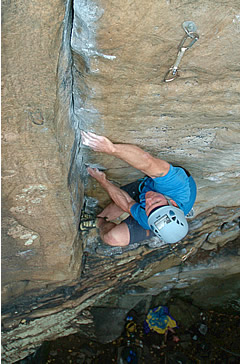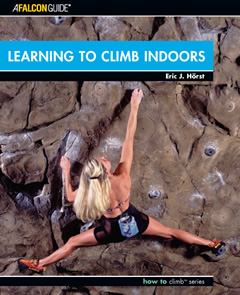Becoming a Master of Your Domain
 Climbing near your limit can be stressful. Desperate moves, risk of falling, and the uncertainty of what’s next can foster unproductive thoughts and physical tension that snowballs at a rapid rate. Left unchecked, such rising tension will cause you to pump out and fall. While every climber has this experience, it should become less frequent as you improve. Increasing confidence and experience will go a long way to mitigate this natural fight-or-flight response.
Climbing near your limit can be stressful. Desperate moves, risk of falling, and the uncertainty of what’s next can foster unproductive thoughts and physical tension that snowballs at a rapid rate. Left unchecked, such rising tension will cause you to pump out and fall. While every climber has this experience, it should become less frequent as you improve. Increasing confidence and experience will go a long way to mitigate this natural fight-or-flight response. Elite climbers with years of experience are zen masters at modulating their emotions and tension on the fly, this way they maintain an optimal performance state throughout the climb. Your goal should be to develop a similar level of awareness and control over rising tension and emotions. You can then use rest stances and clipping positions as an opportunity to release the tension and return to center. Here are two strategies for regaining control in the midst of a difficult route.
Focus on Breath Control
Deep, steady breathing is the number one antidote to tension. Not surprisingly, then, the common tendency to hold your breath on a difficulty sequence is a prime cause of tension. While it’s okay (and often beneficial) to hold your breath for a single challenging move that requires you to bear down hard, it is common to continue to hold your breath, or breathe unevenly, throughout a series of hard moves. By being aware of this tendency, however, you can take conscious control of your breathing during stressful times. Strive for slow, deep belly breaths during the moves leading up to a crux, and try to regain steady breathing as you move out of the most difficult moves. This strategy alone will go a long way toward controlling tension as you climb.
Before you start up a route, try to predetermine the location of all rest stances and clipping positions. These spots should offer you the opportunity to take a minute to steady your breathing. Upon reaching one of these spots, close your eyes for a moment and turn your thoughts inward to feel air filling your lungs with each slow breath. As you exhale, visualize the tension exiting your body and feel a renewed sense of being centered. This entire process might only take fifteen to thirty seconds, but it’s invaluable for regaining an optimal state for attacking the next section of the climb. Make it a habit to steady your breathing at every rest; you might even consider using the ANSWER Sequence at good rest positions that allow you a minute or two to hang out.
Keep Your Thoughts Productive and Goal-Oriented
Doubtful, fearful thinking is an on-sight or redpoint terminator. You simply can’t climb well with the weight of these negative thoughts in tow. Once again, you need to seize every stopping point on a route as an opportunity to tune into your thinking. Is it productive or unproductive in nature? Quickly evaluate any fears to determine if they are legitimate or just phantom fears trying to scare you off the route. In sport climbing, most fears are fraudulent, and if this is indeed the case you must write them off as illusions and then redirect your attention onto your goal—sending the route! Of course, only a fool would ignore real fears (dangers) inherent to trad or highball climbing.
The popular sports metaphor “keep your eye on the ball” is appropriate here. Resist the tendency to doubt your abilities or ponder the fall potential, and simply narrow your focus onto the next section of climb. Attack a route one chunk at a time, and concentrate only on the moves leading to the next rest. If your only goal is climbing the six feet (or whatever) to the next rest position, the burden is greatly reduced and a big cause of tension is erased.
Photo: JS sending at the New River Gorge, WV. Horst photo.
 The essential handbook for every beginner, Learning to Climb Indoors is the most complete instructional book available. Topics covered include beginner and advanced climbing techniques, tactics and climbing strategy, learning to lead climb, basic gear and safety techniques, self-assessment and goal setting, mental training and fear managment, and a primer on physical conditioning and taking your climbing outdoors. This text includes everything you need to know from day one as a climber through your first year or two in the sport. Learn more and buy a signed copy from the author >>
The essential handbook for every beginner, Learning to Climb Indoors is the most complete instructional book available. Topics covered include beginner and advanced climbing techniques, tactics and climbing strategy, learning to lead climb, basic gear and safety techniques, self-assessment and goal setting, mental training and fear managment, and a primer on physical conditioning and taking your climbing outdoors. This text includes everything you need to know from day one as a climber through your first year or two in the sport. Learn more and buy a signed copy from the author >>



 Subscribe to Eric's RSS Feed
Subscribe to Eric's RSS Feed

<< Home